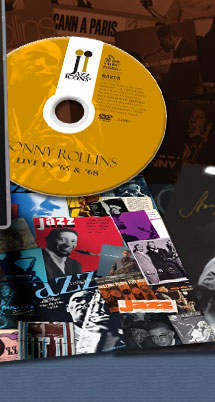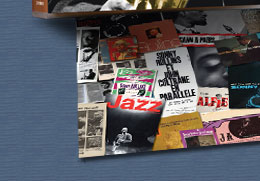




 |
 |
|
|||
|
|
|
||||
|
|
|
||||
|
|
|
||||
|
|
|
||||
 |
|
||||
 |
|
||||
 |
|
||||
|
|
|
|
|
|
|
| Jazz Icons: Sonny Rollins features two intimate concerts filmed in the ’60s for Danish television at the pinnacle of one of his most creative periods. Rollins is joined by some of the most legendary sidemen in jazz history, including 19-year-old Niels-Henning Ørsted Pedersen, drum master Alan Dawson and pianist Kenny Drew. The performances on this DVD feature two incredible versions of his signature tune “St. Thomas,” and reinforce why Sonny Rollins’ incomparable style and genius continue to influence new generations of young jazz musicians. |
|
 |
|
|
|
 |
|
|
|
24-page booklet Liner Notes by Ashley Kahn Foreword by Joe Goldberg Afterword by Joe Lovano Cover photo by Jan Persson Booklet photos by Jan Persson and Lee Tanner Memorabilia collage Total time: 87 minutes |
|
|
Sample of Foreword: STILL SONNY AFTER ALL THESE YEARS More than fifty years ago, I wrote my first set of liner notes for a Sonny Rollins album called Newk’s Time. Twenty-three at the time, a year and a half out of college and working at Sam Goody’s record store in Manhattan, I had first become aware of Sonny by way of his first 12” LP Work Time, which included a version of the ballad “There Are Such Things,” a then current pop tune that I liked. I had never heard it given such power or emotional depth, let alone used as a basis for improvisation; certainly not with the unaccompanied cadenzas Sonny placed at the opening and close of his performance. Fortunately televised performances by artists of Sonny’s stature were far more common in Europe at that time and not only were they broadcast but were preserved as well. As a result we have visual recordings of Sonny live in Copenhagen in both ’65 and ’68, and I have been asked to write a few words for a DVD which is, once again, a Sonny Rollins title. What strikes me most after viewing these exemplary concerts are two things: first, that forty years after its recording, this improvised music has lost none of its power to please. And second, I can’t help but feel that what is today so special by virtue of its preservation, was something that Sonny was then doing nearly every night. I recall years ago telling Sonny that, as others have noted, good as his recordings were, even his finest albums weren’t up to what I’d heard him play live on some nights. “They’re not supposed to be,” he answered. —Joe Goldberg
Sample Liner Notes by Ashley Kahn: After the BridgeHe took me into the room set aside for his exclusive use. Spartan and immaculate, it contained his saxophone… a piano, a copy of the Rosicrucian Creed, a mountain of sheet music, and a set of bar bells. Yet, to Rollins, something was deeply amiss. Dissatisfied with his playing, he placed himself in a creative exile: he stopped performing in public, did not answer his phone, and was discovered practicing alone on the walkway of the Williamsburg Bridge. After months of rumors, Rollins wrote to Down Beat magazine, choosing his words with care to explain his disappearance. “I am at present engaged in numerous pursuits, the most pressing of which are my writing and composing. These endeavors are demanding of the greater portion of my time, concentration and energies and, I feel, will best be seen to fruition by my maintaining a certain amount of seclusion…” Rollins’ absence only amplified his renown. An adoring, curious public awaited his return, and the tenor titan, who could be acutely self-aware and was always self-effacing, knew it. “You won’t be surprised when you hear me,” he warned while still off the scene. “I’m playing just about the way I did before, only I think much better.” When Rollins did reappear in late 1961, crowds welcomed him back, assembling to hear what changes two years of secluded (and outdoor) woodshedding could produce. ... Tivoli Hall, Copenhagen, Denmark—October 31, 1965 The broadcast opens with a stark shot of Rollins and Dawson from behind, both moody silhouettes, as they skip through an up-tempo take of “There Will Never Be Another You.” First performed by the Woody Herman band in 1942 and brought into modern jazz repertory by the likes of Wynton Kelly and Stan Getz, this version is, at 11 ½ minutes, the shortest of the three tunes Rollins performs. In typical fashion, Rollins is locked in a private dance. He steps and sways with his tenor, pushing it side to side, up and back, as his eyes seem to search for a point of focus. Given his propensity to intermittently wander away from the designated microphone, two more were wisely placed on either side to catch all of Rollins’ playing. At times, he tilts his head to the side, suggesting the preferred soloing stance of Lester Young, an early and primary influence. Rollins with shaved head and in dapper turtleneck and jacket is one of his most memorable looks; the flow of his delivery one of his most recognizable assets. Ideas keep pouring from his saxophone—runs, melodic snippets—at a tireless rate, not too fast to be noticed and enjoyed. Is he already soloing on “There Will Never Be…” or is Rollins still in the “head” of the tune, stating its theme? It could be either, given the freedom with which he shifts from, yet returns to the song’s signature melody. At a surprisingly early point in the set, 2 ½ minutes in, Rollins retreats from the microphone, inviting a bass solo. It’s a gesture of confidence in the young Pedersen, an opportunity the bassist fills with a warm, steady tone and agility beyond his years. Rollins gently prods him, blowing rhythmically, before taking a seat and acquainting himself with the bassist’s way of expression. Two minutes later, Pedersen begins to conclude his improvisation as Rollins teases his way back in, trading fours with Dawson. A brief restatement of the melody on the saxophone precedes a spry, bouncing solo from Dawson, with much two-handed snare play. He eventually focuses on a pattern on the hi-hat, and Rollins steps up to bring the tune home, using body English to signal what seems to be the final downbeat, but Rollins immediately tacks on another hallmark of his live sets: an a cappella cadenza, this one a loose collection of riffs. The tune ends to unseen applause with the audience behind a wall of blackness as all lights are trained on the trio. ...
All words and artwork on this page ©Reelin' In The Years Productions. Unauthorized use is prohibited.
|
|
Site contents ©Copyright 2008 Reelin' In The Years Productions
Site designed by Tom Gulotta